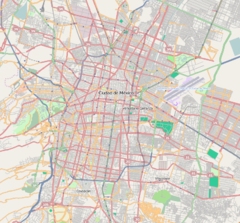Santa Anita metro station
Santa Anita is a station on the Mexico City Metro. Located in Mexico City's Iztacalco borough, the station is the current terminal of Line 4.
General information
The station logo depicts a man sailing a canoe. This is because in the early 20th century, in the area where the station now stands, was the Santa Anita canal – a place used for chinampa-based agriculture. Today the canal has long since vanished, but the name Santa Anita is still used by the surrounding neighborhood.
Metro Line 4 was originally projected to end in the Villa Coapa neighborhood, in the southern borough of Coyoacán. Since the inauguration of Line B, however, no more lines have been constructed or extended, so Metro Santa Anita – and other stations, such as Metro Barranca del Muerto – officially remain provisional terminals. Metro Santa Anita is the least busy station on the Mexico City Metro, with only 621,867 passenger boardings in 2008.[2]
Santa Anita was originally to be named "Plutarco E. Calles", in honor of President Plutarco Elías Calles, according to early plans for Line 4.
Ridership
| Annual passenger ridership (Line 4) | |||||
|---|---|---|---|---|---|
| Year | Ridership | Average daily | Rank | % change | Ref. |
| 2023 | 655,751 | 1,796 | 185/195 | +9.32% | [1] |
| 2022 | 599,848 | 1,643 | 174/195 | +53.41% | [1] |
| 2021 | 391,005 | 1,071 | 193/195 | −12.90% | [3] |
| 2020 | 448,927 | 1,226 | 194/195 | −47.48% | [4] |
| 2019 | 854,706 | 2,341 | 194/195 | −7.26% | [5] |
| 2018 | 921,610 | 2,524 | 194/195 | +6.92% | [6] |
| 2017 | 861,992 | 2,361 | 194/195 | −1.24% | [7] |
| 2016 | 872,802 | 2,384 | 193/195 | −1.30% | [8] |
| 2015 | 884,321 | 2,422 | 186/195 | −16.82% | [9] |
| 2014 | 1,063,158 | 2,912 | 186/195 | +9.75% | [10] |
| Annual passenger ridership (Line 8) | |||||
|---|---|---|---|---|---|
| Year | Ridership | Average daily | Rank | % change | Ref. |
| 2023 | 1,700,415 | 4,658 | 165/195 | +11.62% | [1] |
| 2022 | 1,523,442 | 4,173 | 167/195 | +48.54% | [1] |
| 2021 | 1,025,639 | 2,809 | 174/195 | −25.97% | [3] |
| 2020 | 1,385,490 | 3,875 | 174/195 | −42.34% | [4] |
| 2019 | 2,402,874 | 6,583 | 177/195 | −2.47% | [5] |
| 2018 | 2,463,841 | 6,750 | 176/195 | +6.40% | [6] |
| 2017 | 2,315,712 | 6,344 | 178/195 | −2.01% | [7] |
| 2016 | 2,363,210 | 6,456 | 180/195 | +0.69% | [8] |
| 2015 | 2,347,062 | 6,430 | 170/195 | −4.18% | [9] |
| 2014 | 2,449,436 | 6,710 | 168/195 | +4.70% | [10] |
Exits
Line 4
- Avenida Congreso de la Unión between Canal Nacional street and Viaducto Miguel Alemán, Colonia Santa Anita
Line 8
- East: Avenida Coyuya and Viaducto Miguel Alemán, Colonia Santa Anita
- West: Avenida Coyuya and Viaducto Miguel Alemán, Colonia Santa Anita
References
- ^ a b c d e f g h "Afluencia de estación por línea 2023" [Station traffic per line 2023] (in Spanish). Sistema Transporte Colectivo Metro. 2024. Archived from the original on 27 January 2024. Retrieved 24 January 2024.
- ^ "Index del Sistema de Transporte Colectivo, acciones, cultura, niños". Archived from the original on 2013-10-14. Retrieved 2014-12-08.
- ^ a b "Afluencia de estación por línea 2021" [Station traffic per line 2021] (in Spanish). Sistema Transporte Colectivo Metro. 2020. Archived from the original on 7 March 2022. Retrieved 7 March 2022.
- ^ a b "Afluencia de estación por línea 2020" [Station traffic per line 2020] (in Spanish). Sistema Transporte Colectivo Metro. 2021. Archived from the original on 21 June 2021. Retrieved 21 June 2021.
- ^ a b "Afluencia de estación por línea 2019" [Station traffic per line 2019] (in Spanish). Sistema Transporte Colectivo Metro. 2020. Archived from the original on 8 April 2020. Retrieved 3 May 2020.
- ^ a b "Afluencia de estación por línea 2018" [Station traffic per line 2018] (in Spanish). Sistema Transporte Colectivo Metro. 2019. Archived from the original on 6 June 2019. Retrieved 7 April 2020.
- ^ a b "Afluencia de estación por línea 2017" [Station traffic per line 2017] (in Spanish). Sistema Transporte Colectivo Metro. 2019. Archived from the original on 3 May 2020. Retrieved 3 May 2020.
- ^ a b "Afluencia de estación por línea 2016" [Station traffic per line 2016] (in Spanish). Sistema Transporte Colectivo Metro. 2017. Archived from the original on 3 May 2020. Retrieved 3 May 2020.
- ^ a b "Afluencia de estación por línea 2015" [Station traffic per line 2015] (in Spanish). Sistema Transporte Colectivo Metro. 2016. Archived from the original on 3 May 2020. Retrieved 6 May 2020.
- ^ a b "Afluencia de estación por línea 2014" [Station traffic per line 2014] (in Spanish). Sistema Transporte Colectivo Metro. 2015. Archived from the original on 3 May 2020. Retrieved 6 May 2020.
External links
 Media related to Estación Santa Anita (Metro de México) at Wikimedia Commons
Media related to Estación Santa Anita (Metro de México) at Wikimedia Commons



